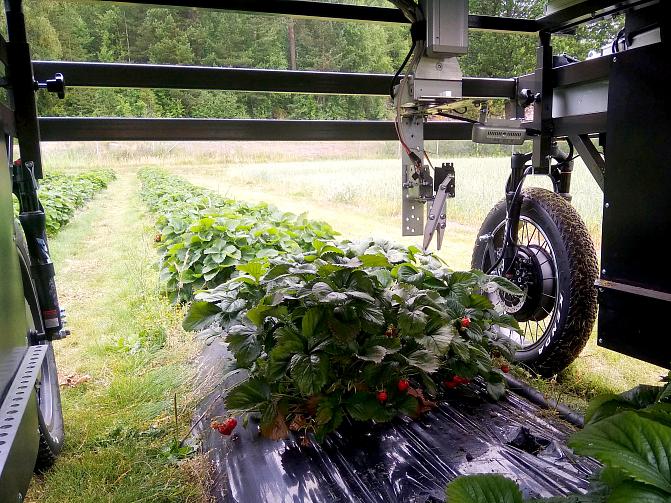
Robotics and artificial intelligence will revolutionise the future of farming
On this page
Robots and artificial intelligence will be part of the future of farming. Robotics will make current production more efficient and enable completely new ways of doing things. AI will help to make agricultural planning more precise and accurate. The Natural Resources Institute Finland (Luke) develops new technologies and promotes their commercialisation.
Luke is developing both robotics and AI methods and applying them to Finnish farming conditions. The aim is to develop solutions that not only make everyday life easier for farmers, but also lay the foundations for sustainable and profitable agriculture in the future. The research will use case study methods, where technology is developed and applied to solve a real-world problem.


Smart and sustainable strawberry farming with robotics
Most commercial robots and other autonomous devices are designed for large farms that can invest in expensive machinery to optimise efficiency. These devices are not well suited to Finnish growing conditions and farm structures. For example, strawberry farms in Finland are often smaller than in large strawberry-producing countries.
Luke started developing robots six years ago with the aim of creating solutions optimised for Finnish conditions. The first project was to develop a strawberry picking robot for open-field strawberry farms, and the next was to develop a robot for strawberry tunnels to combat powdery mildew. The robots developed by Luke are fully electric, small and modular, allowing them to be adapted to different applications in the future.
The robots developed by Luke are fully electric, small and modular, allowing them to be adapted to different applications in the future.
UVC irradiation robot fights plant disease
Powdery mildew is a strawberry disease that has been difficult to control without chemical pesticides. Luke's UVC irradiation robot offers a new, environmentally friendly solution using LED technology.
"UVC irradiation has already proven to be an effective method of microbial control in many applications. However, these applications have used fluorescent lamps, which are energy inefficient and have a shorter life than LED lamps. Thanks to LED technology, the robot consumes less energy, lasts longer and allows precise targeting of the radiation to the plants," says Juha Backman, a senior scientist at Luke.
The robot works autonomously in the strawberry tunnels at night, irradiating the plants. The robot has demonstrated its functionality in tests on a commercial strawberry farm and has been able to work autonomously without constant supervision. In the future, its usability and efficiency will be further developed with a view to its introduction on commercial farms. In particular, research will focus on optimising the irradiation technology and ensuring the robot's performance under different tunnel cultivation conditions.


Strawberry picking robot hoped to ease labour shortage
Labour shortages and picking costs are major problems in strawberry farming, where berry picking is largely a manual operation. The strawberry picking robot developed by Luke is the first solution designed specifically for Finnish open field strawberry farms.
The robot uses machine vision to identify the berries and grabs them by the stem, cutting the stem on the calyx side. The robot hand gently moves the strawberries to the collection box. In initial tests, the robot found the berries efficiently, but further development is needed in terms of picking speed and cutting point detection. Picking efficiency can be improved by increasing the number of robot hands and developing more accurate machine vision algorithms.
Benefits of technology for farmers
Robots developed by Luke offer promising solutions to the challenges facing strawberry farms. They help to make production more environmentally friendly and address labour challenges. In the long term, further development and commercialisation of the robots could revolutionise strawberry farming in Finland.
"The robots are also designed to be modular, so the return on investment can be improved by developing new uses for them in the future. As automation solutions evolve, their operating costs will decrease, making them more attractive to growers," says Backman.



